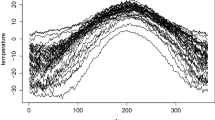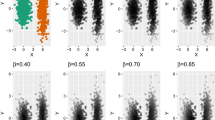Abstract
The concept of data depth leads to a center-outward ordering of multivariate data, and it has been effectively used for developing various data analytic tools. While different notions of depth were originally developed for finite dimensional data, there have been some recent attempts to develop depth functions for data in infinite dimensional spaces. In this paper, we consider some notions of depth in infinite dimensional spaces and study their properties under various stochastic models. Our analysis shows that some of the depth functions available in the literature have degenerate behaviour for some commonly used probability distributions in infinite dimensional spaces of sequences and functions. As a consequence, they are not very useful for the analysis of data satisfying such infinite dimensional probability models. However, some modified versions of those depth functions as well as an infinite dimensional extension of the spatial depth do not suffer from such degeneracy and can be conveniently used for analyzing infinite dimensional data.





Similar content being viewed by others
References
Araujo, A., Giné, E. (1980). The central limit theorem for real and Banach valued random variables. New York: Wiley.
Cuesta-Albertos, J. A., Nieto-Reyes, A. (2008). The random Tukey depth. Computational Statistics & Data Analysis, 52, 4979–4988.
Cuevas, A., Fraiman, R. (2009). On depth measures and dual statistics. A methodology for dealing with general data. Journal of Multivariate Analysis, 100, 753–766.
Cuevas, A., Febrero, M., Fraiman, R. (2007). Robust estimation and classification for functional data via projection-based depth notions. Computational Statistics, 22, 481–496.
Donoho, D. L., Gasko, M. (1992). Breakdown properties of location estimates based on halfspace depth and projected outlyingness. The Annals of Statistics, 20, 1803–1827.
Dutta, S., Ghosh, A. K. (2012). On robust classification using projection depth. Annals of the Institute of Statistical Mathematics, 64, 657–676.
Dutta, S., Ghosh, A. K., Chaudhuri, P. (2011). Some intriguing properties of Tukey’s half-space depth. Bernoulli, 17, 1420–1434.
Fraiman, R., Muniz, G. (2001). Trimmed means for functional data. Test, 10, 419–440.
Ghosh, A. K., Chaudhuri, P. (2005). On maximum depth and related classifiers. Scandinavian Journal of Statistics, 32, 327–350.
Guasoni, P. (2006). No arbitrage under transaction costs, with fractional Brownian motion and beyond. Mathematical Finance, 16, 569–582.
Hansen, B. E. (1991). Strong laws for dependent heterogeneous processes. Econometric Theory, 7, 213–221.
He, X., Wang, G. (1997). Convergence of depth contours for multivariate datasets. The Annals of Statistics, 25, 495–504.
Jörnsten, R. (2004). Clustering and classification based on the \(L_{1}\) data depth. Journal of Multivariate Analysis, 90, 67–89.
Kemperman, J. H. B. (1987). The median of a finite measure on a Banach space. In Y. Dodge (Ed.), Statistical data analysis based on the \(L_1\) -norm and related methods (Neuchâtel, 1987) (pp. 217–230). Amsterdam: North-Holland.
Li, J., Cuesta-Albertos, J. A., Liu, R. (2012). DD-classifier: Nonparametric classification procedure based on DD-plot. Journal of the American Statistical Association, 107, 737–753.
Liu, R. (1990). On a notion of data depth based on random simplices. The Annals of Statistics, 18, 405–414.
Liu, R. Y., Parelius, J. M., Singh, K. (1999). Multivariate analysis by data depth: descriptive statistics, graphics and inference. The Annals of Statistics, 27, 783–858.
López-Pintado, S., Romo, J. (2006). Depth-based classification for functional data. Data depth: robust multivariate analysis, computational geometry and applications, DIMACS Series in Discrete Mathematics and Theoretical Computer Science, 72, 103–119.
López-Pintado, S., Romo, J. (2009). On the concept of depth for functional data. Journal of the American Statistical Association, 104, 718–734.
López-Pintado, S., Romo, J. (2011). A half-region depth for functional data. Computational Statistics and Data Analysis, 55, 1679–1695.
Mosler, K. (2002). Multivariate dispersion, central regions and depth. Berlin: Springer.
Mosler, K., Hoberg, R. (2006). Data analysis and classification with the zonoid depth. Data depth: robust multivariate analysis, computational geometry and applications, DIMACS Series in Discrete Mathematics and Theoretical Computer Science, 72, 49–59.
Mosler, K., Polyakova, Y. (2012) General notions of depth for functional data. Discussion Papers in Statistics and Econometrics 2/2012, University of Cologne (arXiv:1208.1981v1).
Ramsay, J. O., Silverman, B. W. (2005). Functional data analysis. New York: Springer.
Revuz, D., Yor, M. (1991). Continuous martingales and Brownian motion. Berlin: Springer.
Serfling, R. (2002). A depth function and a scale curve based on spatial quantiles. In Y. Dodge (Ed.), Statistical data analysis based on the \(L_1\) -norm and related methods (Neuchâtel, 2002) (pp. 25–38). Birkhäuser: Basel.
Serfling, R. (2006). Depth functions in nonparametric multivariate inference. Data depth: robust multivariate analysis, computational geometry and applications, DIMACS Series in Discrete Mathematics and Theoretical Computer Science, 72, 1–16.
Sun, Y., Genton, M. G. (2011). Functional boxplots. Journal of Computational and Graphical Statistics, 20, 316–334.
Vardi, Y., Zhang, C.-H. (2000). The multivariate \(L_1\)-median and associated data depth. Proceedings of the National Academy of Sciences of the United States of America, 97, 1423–1423.
Zuo, Y. (2006). Multidimensional trimming based on projection depth. The Annals of Statistics, 34, 2211–2251.
Zuo, Y., Serfling, R. (2000). General notions of statistical depth function. The Annals of Statistics, 28, 461–482.
Acknowledgments
Research of the first author is partially supported by the SPM Fellowship of the Council of Scientific and Industrial Research, Government of India. The authors would like to thank an anonymous referee for several comments and suggestions.
Author information
Authors and Affiliations
Corresponding author
About this article
Cite this article
Chakraborty, A., Chaudhuri, P. On data depth in infinite dimensional spaces. Ann Inst Stat Math 66, 303–324 (2014). https://doi.org/10.1007/s10463-013-0416-y
Received:
Revised:
Published:
Issue Date:
DOI: https://doi.org/10.1007/s10463-013-0416-y




